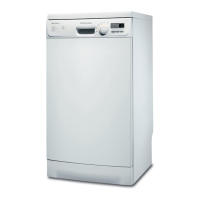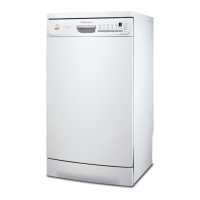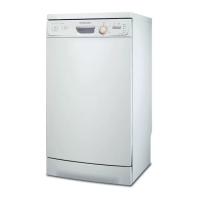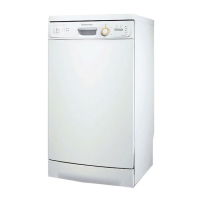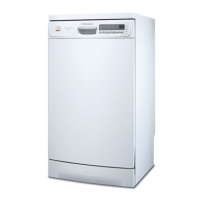Do you have a question about the Electrolux ESF 472 and is the answer not in the manual?
Determining the optimal location for the dishwasher unit.
Ensuring the appliance is perfectly level for correct operation.
Modifying the worktop position to align with kitchen units.
Procedure for fitting the appliance beneath a kitchen counter.
Attaching a custom decorative panel to the appliance door.
Connecting the dishwasher to the main water inlet.
Connecting the drain hose to the waste water system.
Connecting the appliance safely to the electrical power supply.
Instructions for replacing the appliance's power cable.
Identification and explanation of all control panel buttons and indicators.
Detailed meaning of the various symbols displayed on the control panel.
Overview of the available washing programmes for selection.
Operation of the main power on/off button.
Function for selecting the desired water heating temperature.
Enabling a more energy-efficient drying cycle.
How to correctly open the appliance door.
Indicator light status and its meaning.
Method for selecting the washing programme using the dial.
Display showing the current stage of the washing cycle.
Notification for when the salt reservoir needs refilling.
Explanation of the water softening system and its function.
Steps to adjust the water softener to local water hardness.
Instructions for correctly filling the salt compartment.
Purpose and benefits of using rinse aid.
Procedure for refilling the rinse aid dispenser.
Setting the optimal rinse aid dosage for drying.
General guidelines for efficient dish loading.
Proper arrangement of items in the lower basket.
Proper arrangement of items in the upper basket.
How to change the vertical position of the upper basket.
Reversing the upper spray arm for improved wash performance.
Tips for achieving optimal washing and drying results.
Methods and practices for reducing energy consumption.
List of crockery and utensils that should not be washed.
Practical demonstration of selecting and running a wash programme.
Description of standard wash cycles for different soil levels.
Description of programmes designed for energy and water saving.
Details on specific programmes like Quick wash and Rinse and Hold.
Procedure for cleaning the central filter assembly.
Procedure for cleaning the main large filter.
Routine cleaning of the appliance's interior and exterior surfaces.
Recommendations for storing the appliance during long periods of disuse.
Understanding the risks of freezing and how to prevent damage.
Steps for safely relocating the dishwasher unit.
Troubleshooting steps for when the appliance fails to start.
Troubleshooting steps for issues with water intake.
Troubleshooting steps for problems with water drainage.
Troubleshooting steps for poor washing performance and results.
Further troubleshooting advice for persistent cleaning issues.
Addressing issues related to hard water deposits on dishes.
Troubleshooting specific residue marks on washed items.
Troubleshooting causes and solutions for appliance noise.
Troubleshooting steps for inadequate drying of dishes.
Determining the optimal location for the dishwasher unit.
Ensuring the appliance is perfectly level for correct operation.
Modifying the worktop position to align with kitchen units.
Procedure for fitting the appliance beneath a kitchen counter.
Attaching a custom decorative panel to the appliance door.
Connecting the dishwasher to the main water inlet.
Connecting the drain hose to the waste water system.
Connecting the appliance safely to the electrical power supply.
Instructions for replacing the appliance's power cable.
Identification and explanation of all control panel buttons and indicators.
Detailed meaning of the various symbols displayed on the control panel.
Overview of the available washing programmes for selection.
Operation of the main power on/off button.
Function for selecting the desired water heating temperature.
Enabling a more energy-efficient drying cycle.
How to correctly open the appliance door.
Indicator light status and its meaning.
Method for selecting the washing programme using the dial.
Display showing the current stage of the washing cycle.
Notification for when the salt reservoir needs refilling.
Explanation of the water softening system and its function.
Steps to adjust the water softener to local water hardness.
Instructions for correctly filling the salt compartment.
Purpose and benefits of using rinse aid.
Procedure for refilling the rinse aid dispenser.
Setting the optimal rinse aid dosage for drying.
General guidelines for efficient dish loading.
Proper arrangement of items in the lower basket.
Proper arrangement of items in the upper basket.
How to change the vertical position of the upper basket.
Reversing the upper spray arm for improved wash performance.
Tips for achieving optimal washing and drying results.
Methods and practices for reducing energy consumption.
List of crockery and utensils that should not be washed.
Practical demonstration of selecting and running a wash programme.
Description of standard wash cycles for different soil levels.
Description of programmes designed for energy and water saving.
Details on specific programmes like Quick wash and Rinse and Hold.
Procedure for cleaning the central filter assembly.
Procedure for cleaning the main large filter.
Routine cleaning of the appliance's interior and exterior surfaces.
Recommendations for storing the appliance during long periods of disuse.
Understanding the risks of freezing and how to prevent damage.
Steps for safely relocating the dishwasher unit.
Troubleshooting steps for when the appliance fails to start.
Troubleshooting steps for issues with water intake.
Troubleshooting steps for problems with water drainage.
Troubleshooting steps for poor washing performance and results.
Further troubleshooting advice for persistent cleaning issues.
Addressing issues related to hard water deposits on dishes.
Troubleshooting specific residue marks on washed items.
Troubleshooting causes and solutions for appliance noise.
Troubleshooting steps for inadequate drying of dishes.
| Type | Freestanding |
|---|---|
| Place settings | 12 |
| Energy efficiency class | A |
| Washing class | A |
| Drying class | A |
| Width | 60 cm |
| Height | 85 cm |
| Delay start | Yes |



